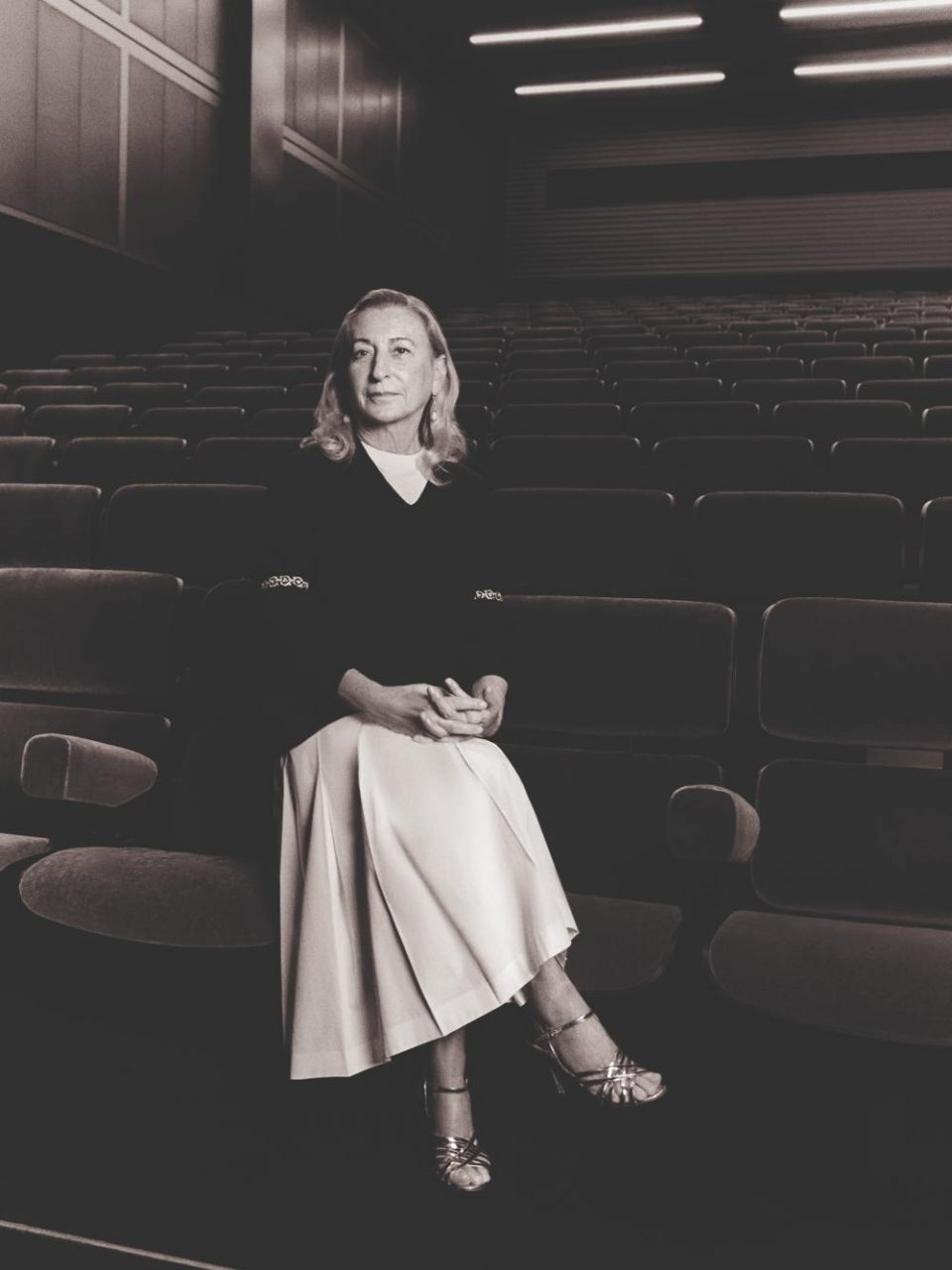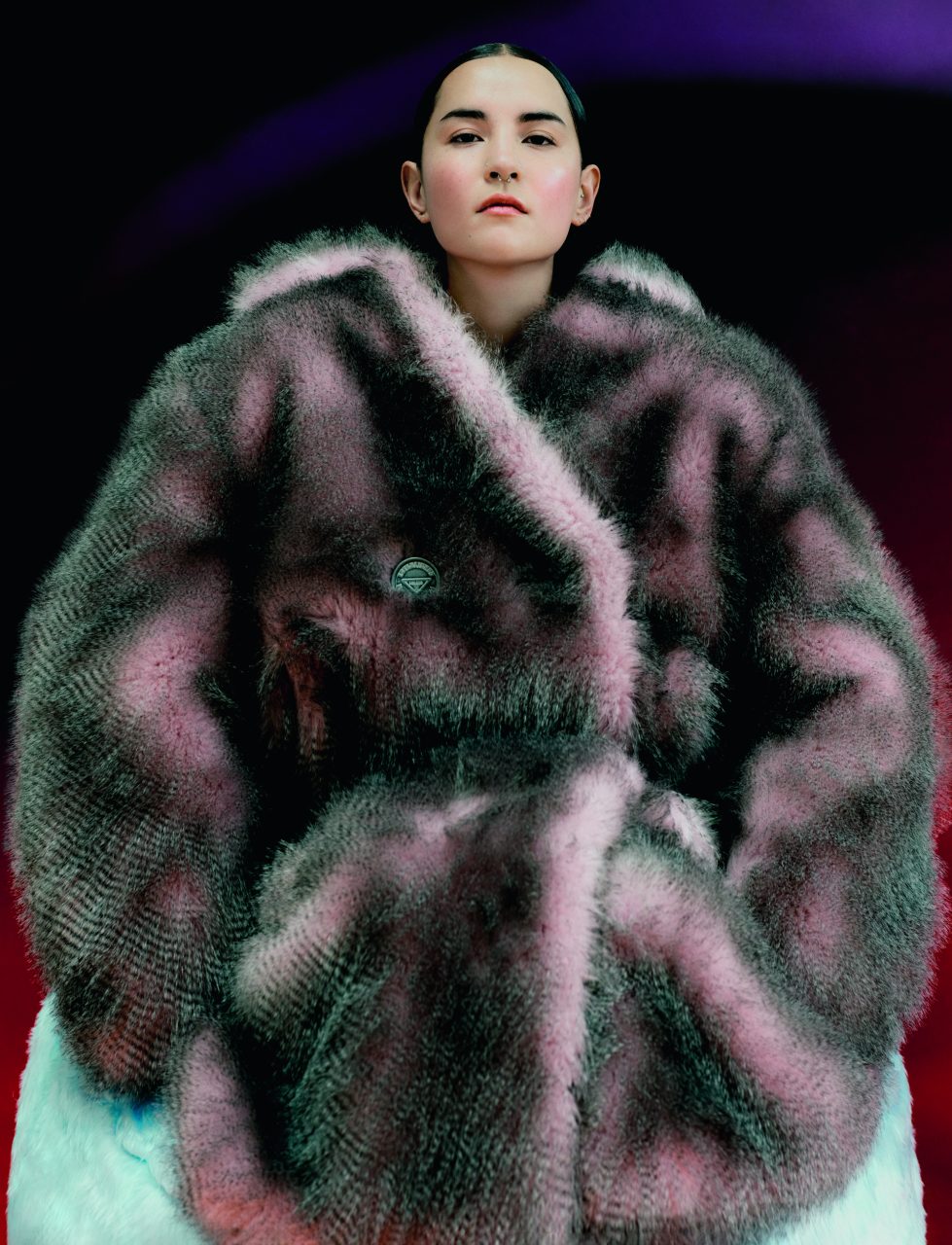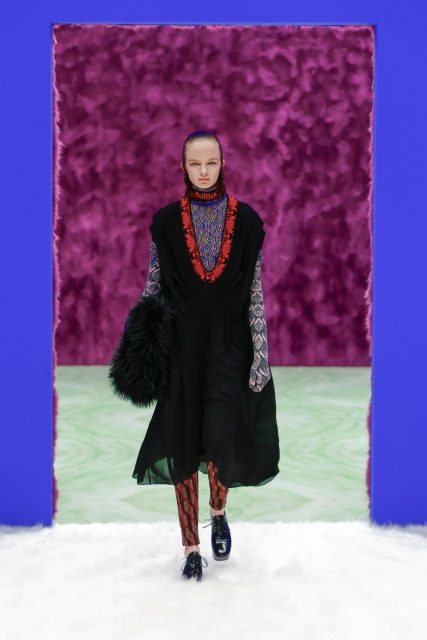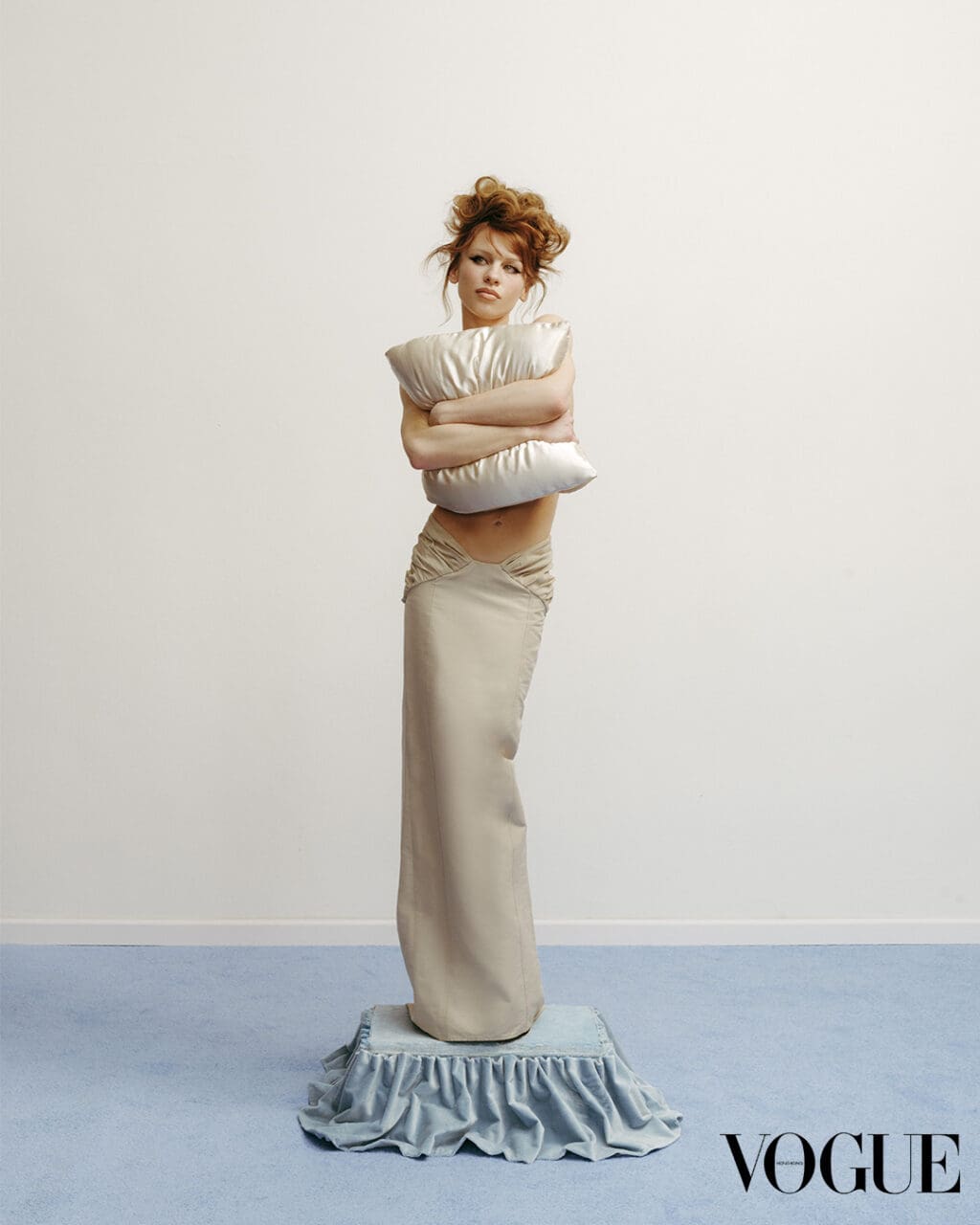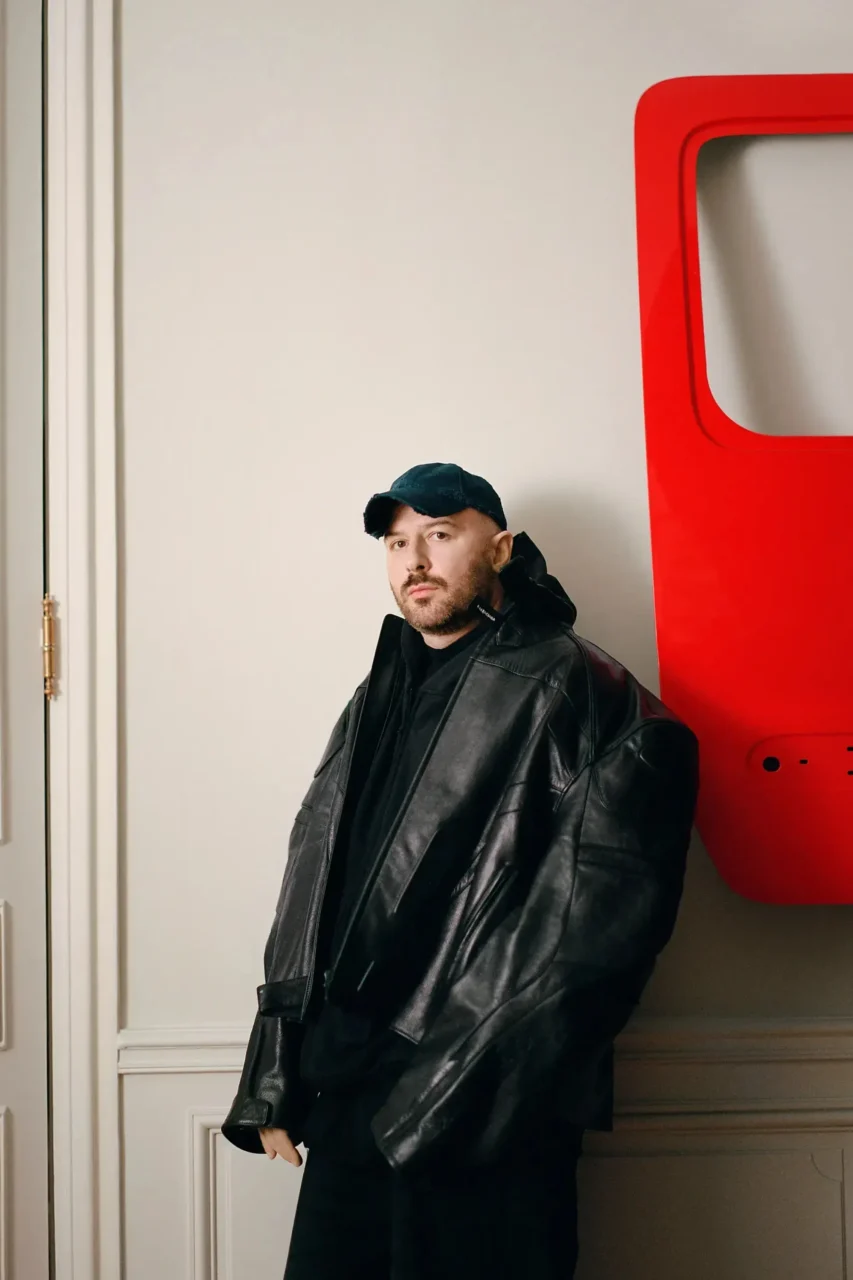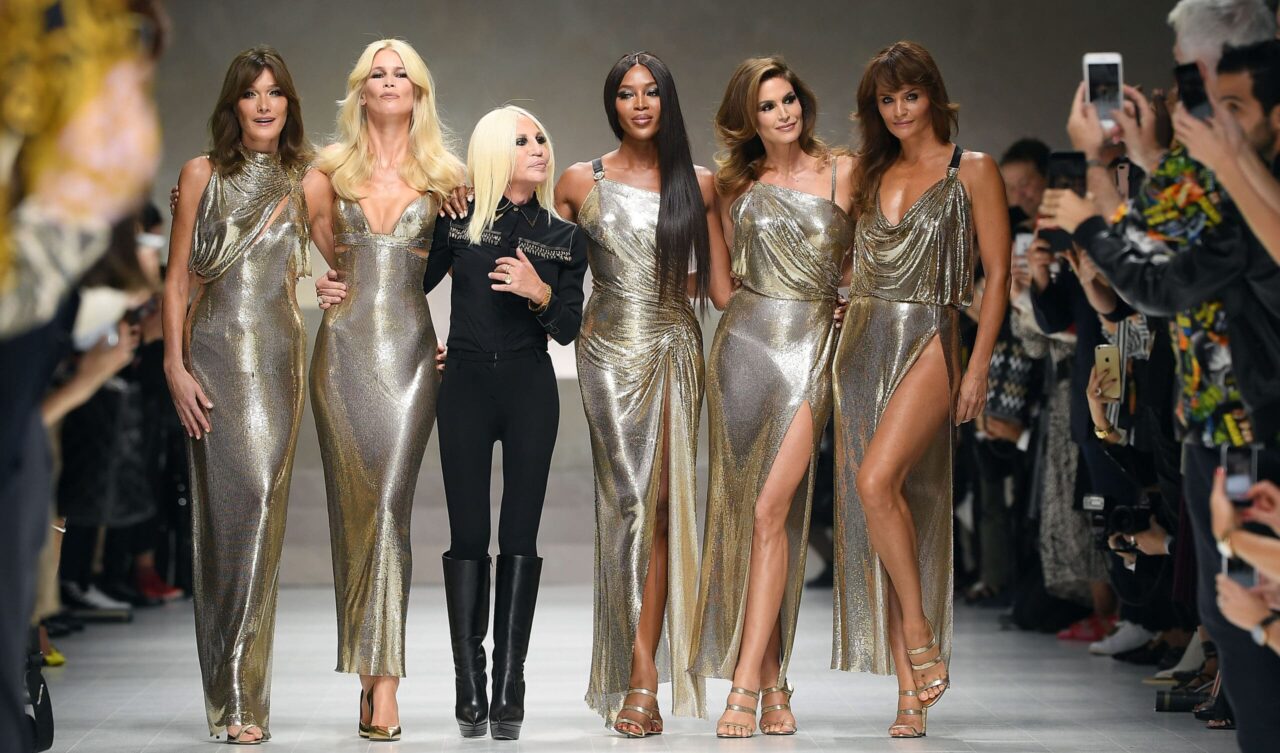Miuccia Prada does not like collaborations. “I’ve been asked to do a collaboration since ages!” she exclaims, in heavily accented English. “They always seemed to be just about selling more – about clichés, banality, and not about ideas. I was never interested.”
She is sitting in her Milan office alongside her new counterpart, Prada co-creative director Raf Simons, as I count contradictions. Even without the presence of Simons here in the nerve centre of Prada HQ, however, it is clear to any devotee that what’s happened to the label is most definitely a collaboration: since February 2020, when the partnership was first announced – prompting great surprise and intrigue – the fingerprints of both designers have been stamped all over the Prada collections, as plain to see as the omnipresent triangular logo.
The pair have so far produced two women’s collections. Spring/summer 2021 (launched via a Covid-era live-streamed show last September) was a tightly curated series of minimalist silhouettes, structured skirts and playful fabrics. Among the wearable monochrome prints and clutched anoraks, the collection delivered a new Prada classic: a glamorous A-line skirt with an airline seat-belt waist – which somehow managed to be both Miuccia Prada, PhD, and sculptural showstopper Simons – irresistibly paired with irreverent punctured turtlenecks.
In February, the house revealed an a/w 2021 collection – seen here on some of the new generation of screen actors – that offered an endless dialogue between looks that veered between psychedelic colour and optimistic sensuality, between defensive armour and purple, patterned platform boots. The set, a multi-textural ode to touch, was a reminder of Mrs Prada’s collaborations with Dutch architect and theorist Rem Koolhaas.
We toyed with switching roles — I heading up Raf Simons, he at Prada.
Miuccia Prada
How exactly the two designers jointly create these collections, though – something I try to glean from Mrs Prada, 73, and Simons, 53 – remains gloriously elusive. “We start with dialogue,” says Simons. “We talk about last season, we talk about ideas and feelings, and out of that we start small things to grow. But everything starts with dialogue.”
“That’s what makes a good designer,” adds Mrs Prada. “First, you have to have good thoughts, and then you have to be able to translate them. When I do not have a precise idea already, I always ask myself, ‘What really interests me?’ Maybe it’s a place, maybe it’s a colour, maybe it’s an emotion. And then I attach to that fabric, and I try to understand why I am attracted to something. In a practical way, you start with an aesthetic. The process lasts months.”
“The collaborative part,” Simons adds, “is easy, easy, easy. It’s very easy. The nature of how we design is not so disconnected from each other. There are designers who go sit at a desk and start to sketch and everything. We are both so not like that!”
“I hoped he would be able to, because I’m not able,” Mrs Prada says, laughing.
A woman whose every appearance is deconstructed as a style inspiration, she does not disappoint in person. Her shoulder-length blonde hair is pinned in a gentle, side-parted wave, revealing gemstone earrings (carnelian, perhaps, which stimulates creativity) intricately set in gold. She wears a brown checked trouser suit over an untucked pink shirt – so far, so demure – but then come her shoes: a furry pair of gleaming, pearl-encrusted Miu Miu slides.
“I love the look,” says Simons, who is dressed in slim black trousers, minimalist utilitarian ankle boots, and his trademark oversized jumper, a blue collar peeping through. The admiration is both real and reciprocated.
There is, frankly, no precedent for two designers each so successful in their own right – with the Raf Simons label now a quarter of a century strong and Prada showing no signs of decreasing in either influence or sales – joining forces. The decision came about, as they recount it, after a long period of mutual appreciation.
“I like only a very small number of brands, and Prada is one of the few that I would wear,” says Simons, who earlier in his career notoriously felt awkward about wearing his own label, choosing a diet of Prada and Helmut Lang instead. Then, in 2005, Mrs Prada and her husband, Prada Group CEO Patrizio Bertelli, appointed Simons to be creative director at Jil Sander.
“That’s something to never forget,” Simons says. “My brand was so much seen as the avant-garde of menswear, and Jil Sander was so different. They saw something that nobody else had seen – or would dare to risk.” Each continued to follow the other’s work – until they met up after a 2015 Miu Miu show in Tokyo and had what both describe as “an open conversation”.
“Very open,” Mrs Prada emphasises. “We thought, ‘What can we do?’ We toyed with switching roles – I heading up Raf Simons, he at Prada,” she says, laughing again.
“It was very daring, this collaboration,” says Koolhaas over Zoom. “It fits completely with Prada’s interest in experimentation, and it’s still surprising: there is not yet a feeling of routine – or anything like it – so it feels charged with potential.”
We talk about ideas and feelings, and small things grow. Everything starts with dialogue.
Raf Simons
It also explores the increasingly relevant question of what collaborations mean in fashion today. In this once-unimaginable era in which not only Prada and Raf Simons are joining forces, but also Balenciaga and Gucci (albeit described as not so much a collaboration but a one-off “hack”), it’s hard to avoid the conclusion that there has been a profound shift away from the idea of the auteur as a kind of singular, dictatorial creative genius and towards a more communal approach to both design and brands in general. (Simons now embraces his co-creative director role at Prada while continuing to lead his own label, while Mrs Prada maintains her own sphere of sole influence in Miu Miu, where Simons plays no part.)
Linda Loppa, who taught Simons during the 25 years when she headed up the fashion department at Antwerp’s prestigious Royal Academy of Fine Arts, regards her former student’s venture with Prada as almost inevitable.
“I’m not really surprised that it’s Raf Simons and Prada who are doing this,” Loppa tells me, “because these two persons are not really the stars we expect they should be as fashion designers. They are outsiders – they kept their personality, and they have a common feeling about how to behave in this complex society. We are in a moment of really important change, and we have to reflect that in the way we work.”
Simons’s career has been punctuated by sublime riffs on radical youth culture – his 2001 Riot Riot Riot collection was famously inspired by the post-Soviet generation of young Eastern Europeans, and his 2011 Jil Sander Techno Couture collection, which featured Busta Rhymes on the soundtrack and models radiating an acid colour palette, was hailed as a transformative moment for the brand.
The questions – if not the answers – raised by the cultural and political moment are something that has driven both Simons and Mrs Prada throughout their careers – and one can’t help but feel that it’s their common interest in trying to square its contradictions that animates both their friendship and their work together. They seem to take particular pleasure in digging into their dislikes, their fears and their discomforts – whether that’s about linen, which both profess to hate, or something more abstract. “First you hate something, then you investigate why you hate something,” Mrs Prada says. “That is exciting – and for creative people, to be excited is the only way.”
What excites both designers right now is the drift towards capitalist and populist politics. “People are becoming so incredibly conservative,” Mrs Prada says. “I want to do a show about that, because that is the truth.” Neither she nor Simons will say more, but as I probe whether their spring/summer 2022 collection will be about satirising right-wing movements, they exchange knowing looks with each other.
“I think we’re both really interested in trying to understand the world and how it’s evolving,” Simons says, “and how that reflects on how people look at fashion and at clothes. It’s changing a lot, and it’s a generational thing.”
Mrs Prada, who has spent her storied career confounding both expectations and notions of luxury, echoes those thoughts. “Through my job, I show my ideas,” she says. “So I take my job very seriously.”
And – after more than five decades at Prada – the notion of not doing that job isn’t something she’s entertaining.
“Why is it,” she asks, emphatically, “that we ever have to stop working? I’m doing what I want.”
Prada Models
Simone Ashley
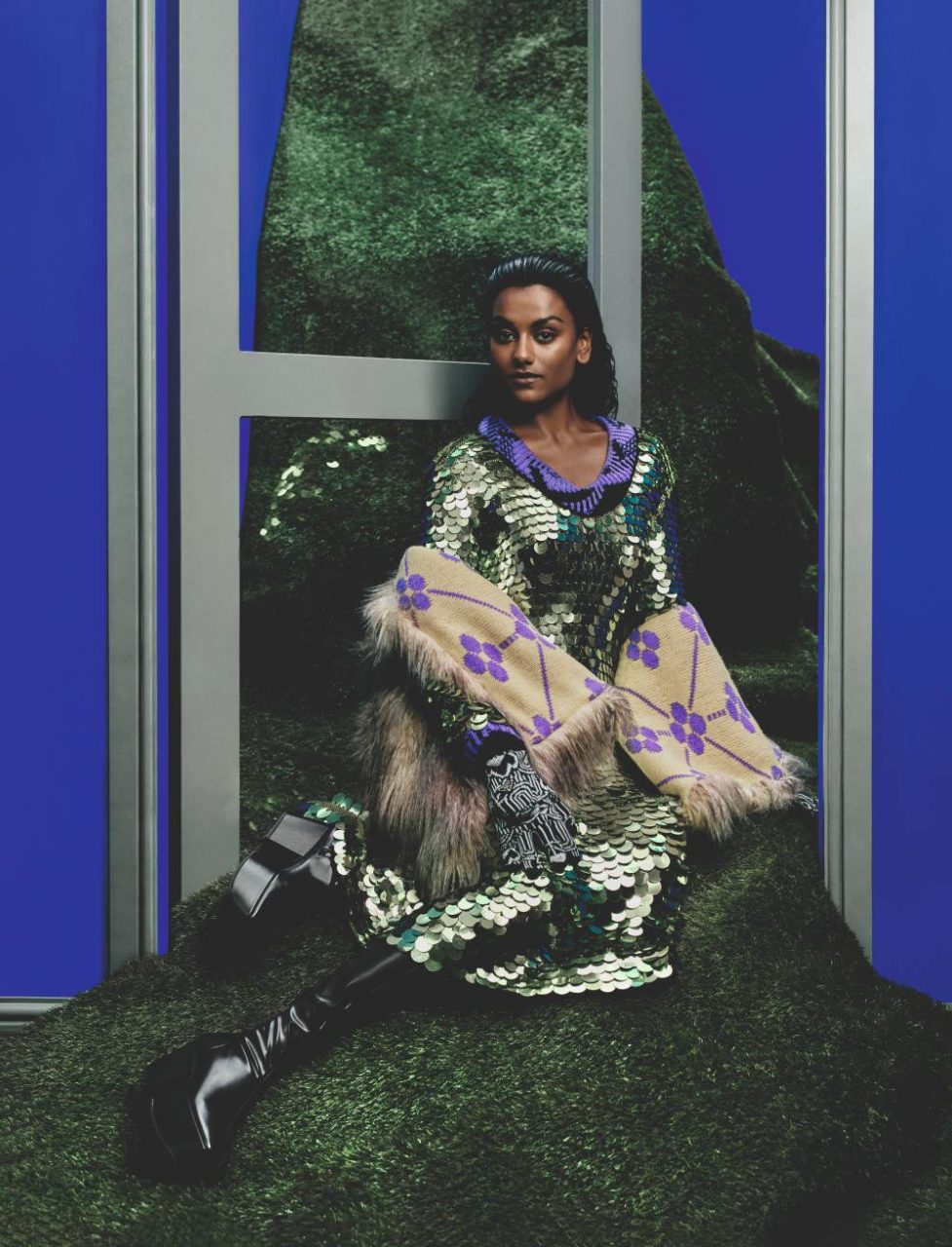
Sequined knit dress, faux-fur and jacquard stole, leather boots, wool gloves, all Prada.
Photo: Rafael Pavarotti
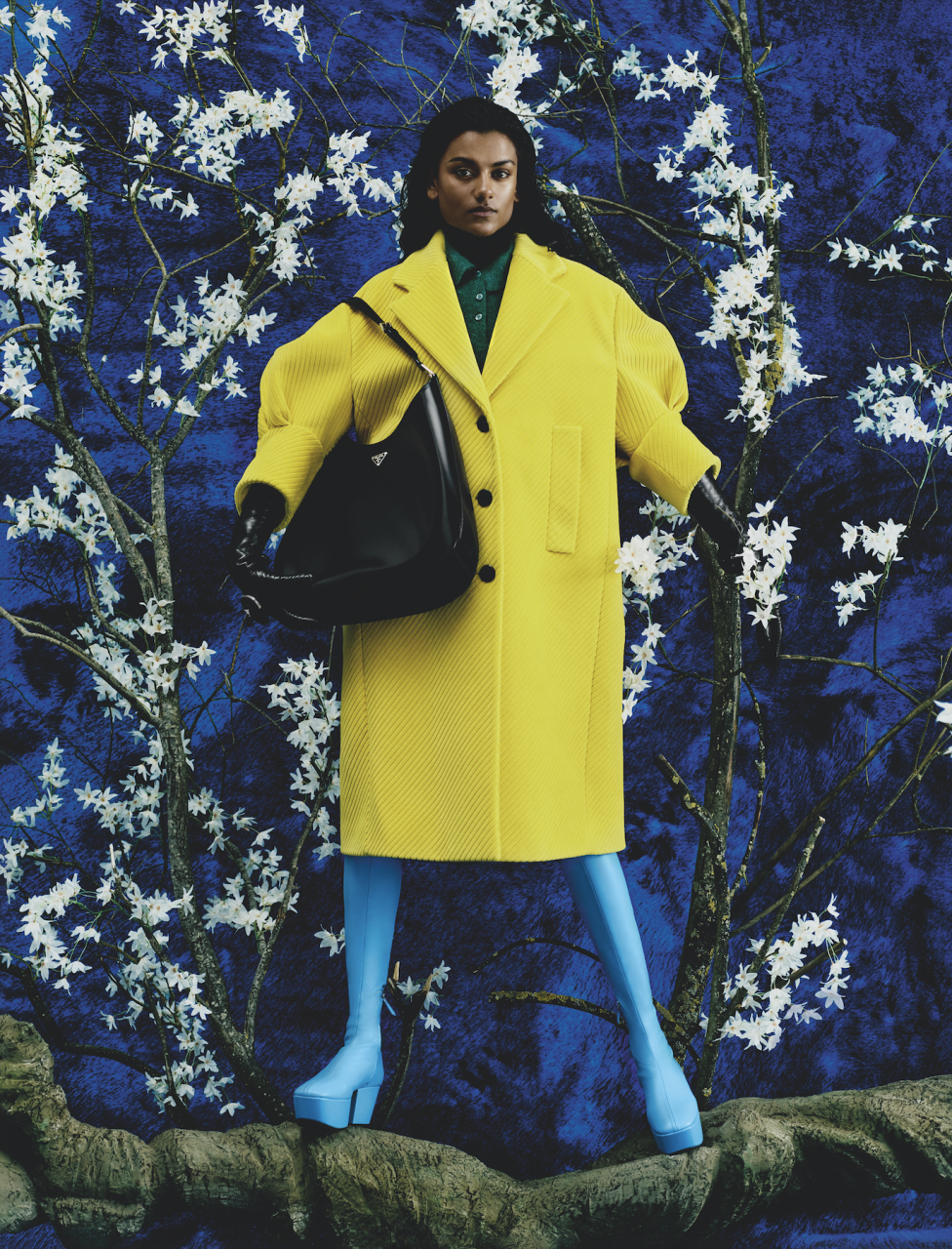
Prada Crayola's bright coat and boots combo is one for the thrill seekers not wallflowers. Courduroy coat, wool polo shirt, wool poloneck, leather boots, leather bag, leather gloves, all Prada.
Photo: Rafael Pavarotti
“I love the gloves!” exclaims Simone Ashley of this look. “Why are gloves so sexy?” This bodes well. Ashley, 26, may be best known as mean queen Olivia in Netflix’s Sex Education, but soon the Surrey-born, LA-dwelling actor will be donning gloves (and bonnet) as the new lead in series two of hit costume drama Bridgerton – watched by 82 million households and counting. How does it feel? “The entire cast and crew have been working so hard,” she says. “I try not to think too much about what’s next. I find it easier to be grateful…and just give it all I’ve got.”
Emma Corrin
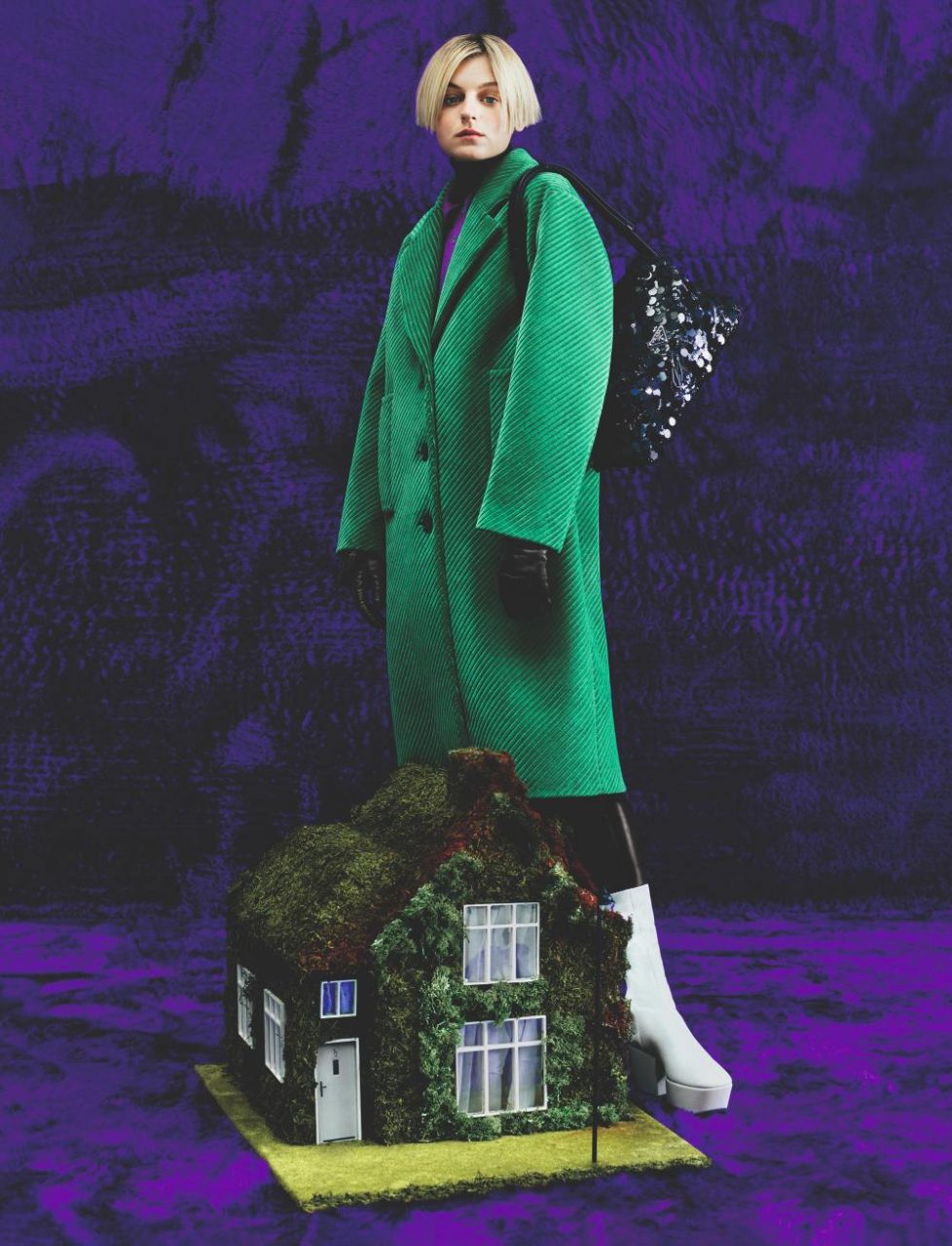
Corduroy coat, wool polo shirt, wool poloneck, leather boots, to order. Sequined bag, leather gloves, all Prada.
Photo: Rafael Pavarotti
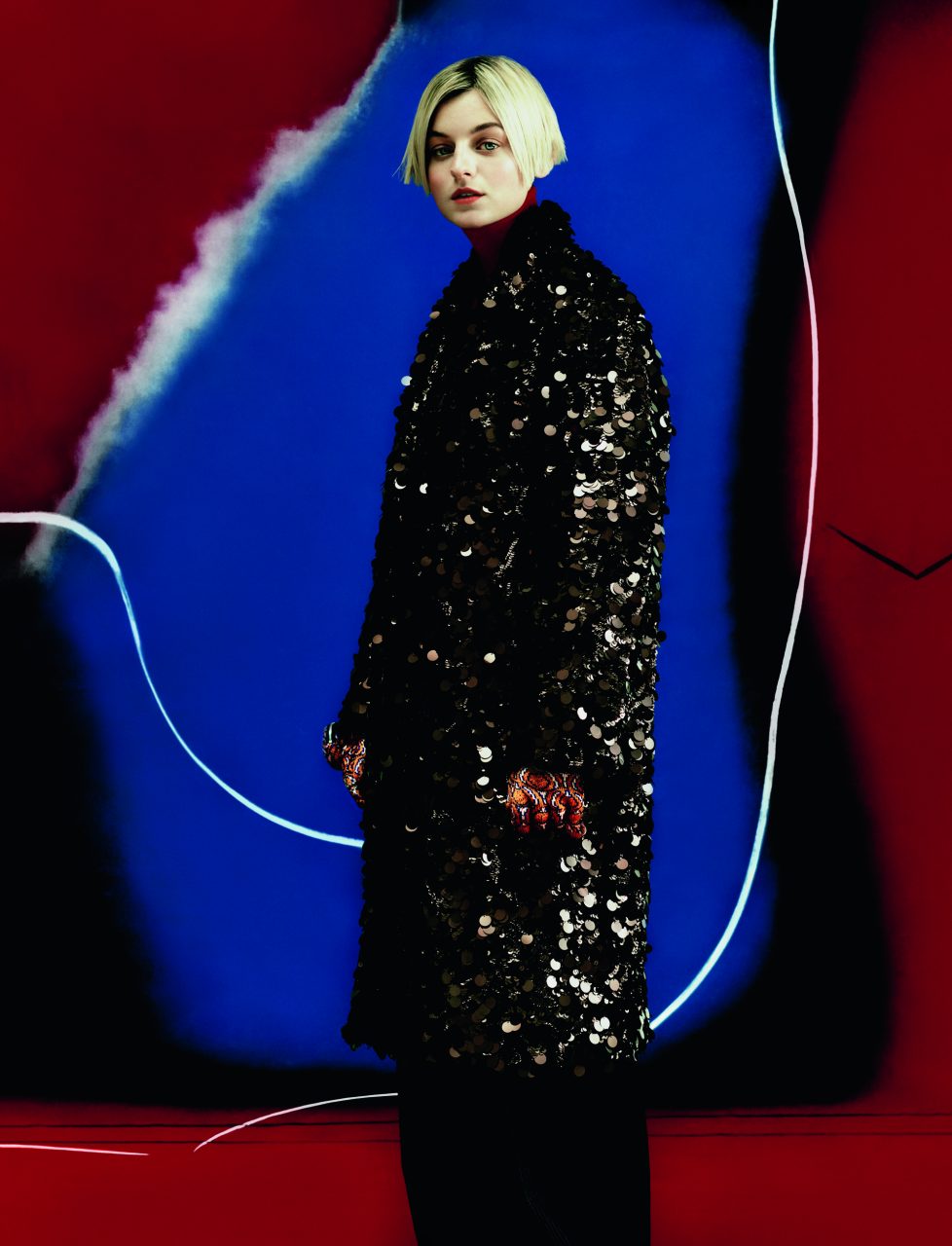
Chocolate-coloured palettes turn razzle-dazzle on its head - and we're ready to indulge. Sequinned coat, wool poloneck, flannel trousers, wool gloves, all Prada.
Photo: Rafael Pavarotti
What “new beginning” is Emma Corrin, 25, most looking forward to this autumn? “Pretending I’m going back to school and buying myself bouquets of sharpened pencils,” says the actor, with trademark whimsy. Of course, Corrin is too modest to mention upcoming film projects, although they will next star opposite Harry Styles in 1960s-set My Policeman before taking up duties as Lady Chatterley in a new big-screen adaptation of the DH Lawrence classic. Ever since playing Diana, Princess of Wales, with eerie accuracy in The Crown, Corrin has been a star to watch, as well as a captivating red-carpet presence (remote, or otherwise). “Colour, sophistication and imagination all mixed into one,” Corrin coos of the Prada collection.
Jessie Mei Li
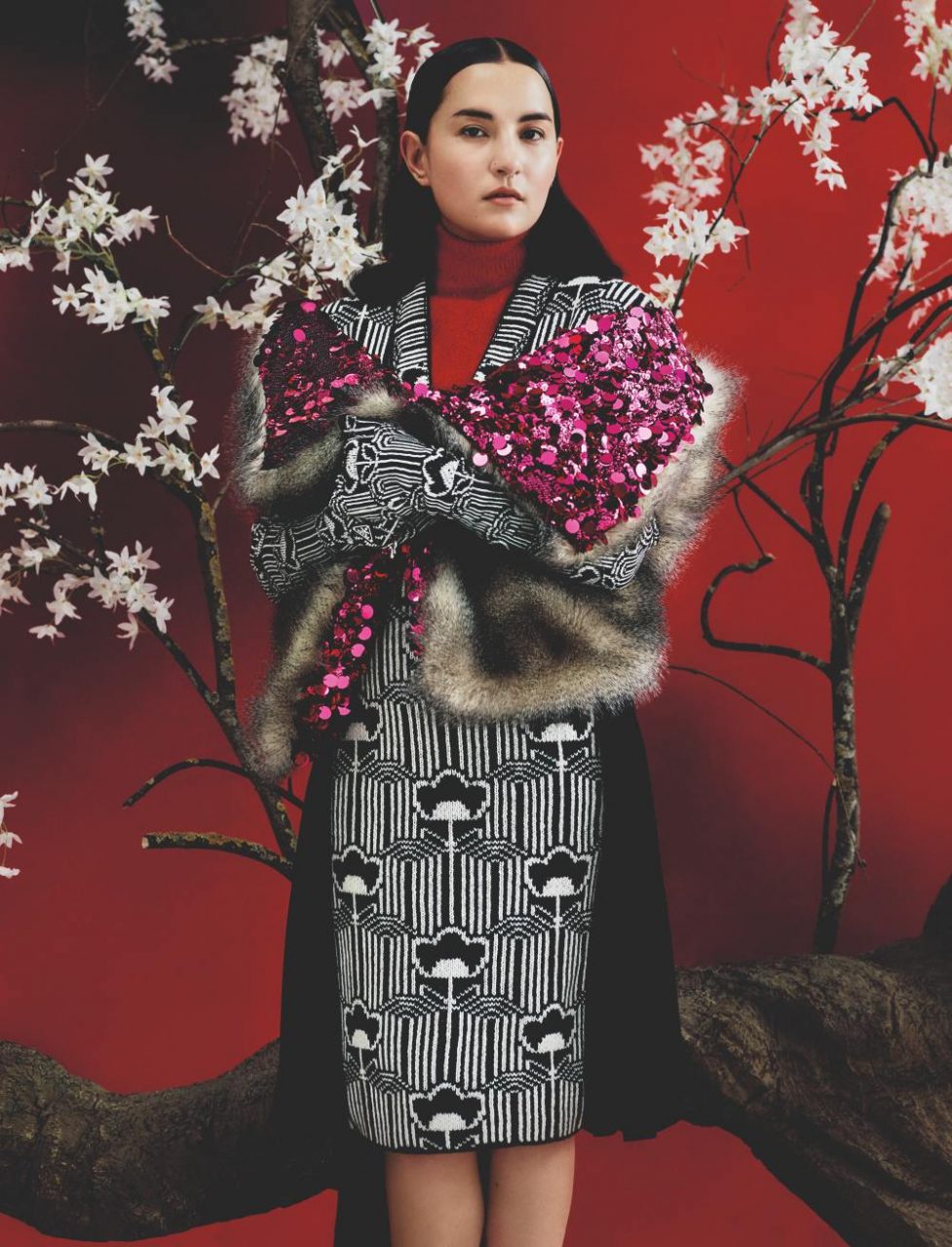
Sequined faux-fur stole, sleeveless jacquard and georgette dress, wool poloneck, wool opera gloves, all Prada.
Photo: Rafael Pavarotti
“I’ve had a lot of time to myself this past year, which I really needed,” says Jessie Mei Li of preparing for her next chapter, namely: fame. From her lead performance as Alina Starkov in Netflix’s hit fantasy Shadow and Bone (series two is in the works), to her upcoming role in Edgar Wright’s film Last Night in Soho alongside Anya Taylor-Joy, 2021 marks the year the 25-year-old arrived. “I’m not one to plan ahead, but hopefully I’ll find myself in some interesting places,” she says. “I like not knowing what’s coming my way.”
Wunmi Mosaku
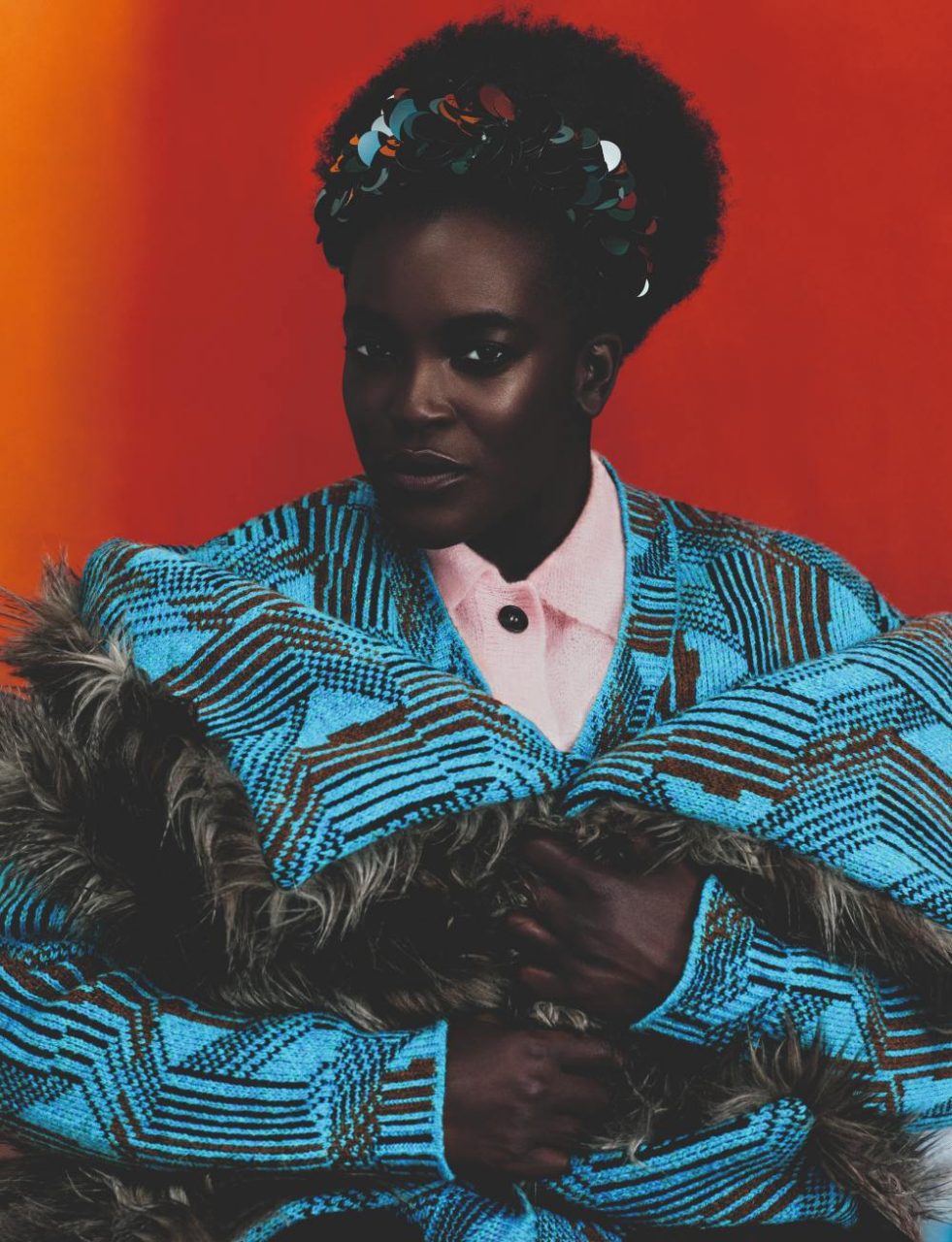
Jacquard and faux-fur stole, jacquard cardigan, wool buttonthrough cardigan, sequined headband, all Prada.
Photo: Rafael Pavarotti
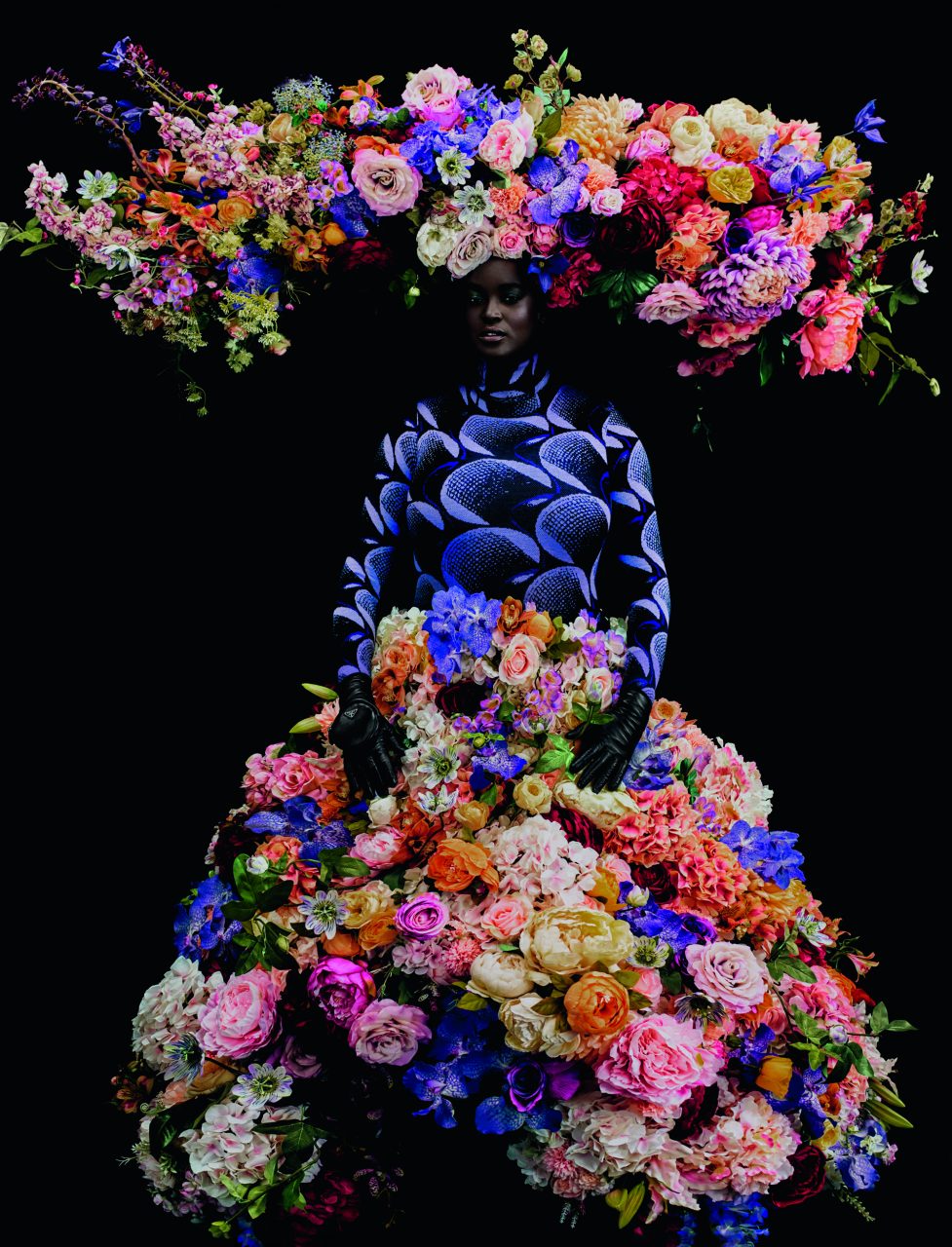
"Optimism is mounting," said Miuccia Prada post show. Wunmi Mosaku — positively blooming — takes the idea and runs with it. Wool jumpsuit, leather gloves, clothes and accessories, all Prada.
Photo: Rafael Pavarotti
This past year has been a joy for fans of Wunmi Mosaku. In March, the 35-year-old Mancunian, who now lives in LA, received a lead actress nomination at the Baftas for His House (she already has a TV Bafta), and gave star turns in small-screen hits Lovecraft Country and Marvel’s Loki. Next up? “I’m excited for Call Jane to come out,” she tells Vogue, of co-starring with Sigourney Weaver in a film “about women’s reproductive rights in the 1960s”. It is her mission to work on projects with real meaning, and, with US abortion legislation again under scrutiny, she says, “Sadly it couldn’t come at a more timely moment.”
Photographer:Rafael Pavarotti
Stylist: Edward Enninful
Hair: Eugene Souleiman
Make-up: Ammy Drammeh
Nails: Ama Quashie
Set design: Ibby Njoya
Flowers: S2 Events
Production: Lalaland Production
Digital artwork: Dtouch London
Editor
Afua HirschCredit
Lead Image: Photography by Rafael Pavarotti
